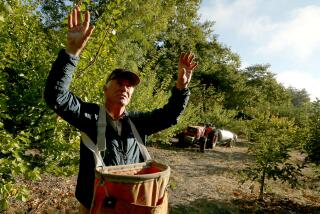Washington Apple Growers Launch $20-Million Campaign
- Share via
Washington apple growers, stuck with a bumper crop at a time when exports are down, have launched a $20-million advertising blitz to persuade consumers to eat an extra apple a month.
The goal is ambitious, given that consumption of apples in the United States has been flat for the last 15 years, in part because consumers don’t find apples as tasty as other fruits and snacks.
But apple growers have little choice but to persuade Americans to eat more. Shipments to Asia, the industry’s most important export market, plummeted nearly 43% last year, a result of that region’s economic woes. Exports to other regions are also down.
At the same time, growers anticipate a record crop of 96 million boxes, or 4 billion pounds of apples, a 20% increase over last year.
Commercials airing in Los Angeles and 19 other cities pitch apples as a convenient energy food. In the ads, motorcycle-riding superhero Apple Guy spots on his radar screen people in need of a pick-me-up. He zooms to the rescue to deliver shiny, crisp Washington apples that revive the flagging recipients after one bite.
“Washington Apples. Just the Thing,” is the tag line.
The Washington Apple Commission’s marketing program also focuses heavily on retailers, offering them incentives--such as advertising “tags” that mention their stores--to pass along lower apple prices to consumers.
The average retail price per pound for Red Delicious apples in January was 86 cents, down 6 cents--a 6.5% drop--from the previous year, according to Bureau of Labor Statistics figures.
The wholesale price has skidded about 25% in the same period.
The commission also is encouraging retailers to advertise and prominently display Washington apples.
“Shelf space is really the critical ingredient” for commodity sales, UC Davis agricultural economist Roberta Cook said. “Anything groups can do to increase shelf space and positioning has a positive effect on sales.”
Other Shortages May Boost Apple Sales
Washington apple growers agree that it won’t be easy to get consumers to change their eating habits.
“It takes big media pressure,” said Jim Thomas, Washington Apple Commission spokesman. “And you’re competing with many others for share of stomach.”
There also is a debate as to whether some high-profile campaigns--including the familiar “milk mustache” advertising from the National Fluid Milk Processor Promotion Board, has been cost-effective. The U.S. Department of Agriculture is in the process of reviewing the effectiveness of some commodity advertising, including the milk mustache campaign.
But the woes of other fruit producers may work in favor of the apple growers. A shortage of other popular fruits help boost apple sales, observers say.
“The hurricane in banana-producing areas has meant relatively high prices for bananas, and the Christmas freeze in California took care of the navel oranges,” UC Davis agricultural economist Hoy F. Carman said. “Those and pears are probably the only substitutes.”
And, the apple commission says that so far its ads seem to be working. Apple sales are up overall, and the increases are 50% higher in markets where the commercials appear, the commission said.
The commission’s agency, McCann-Erickson in Seattle, created the ad situations based on what mothers told them was the best time to eat apples: as a pick-me-up while shopping, at midafternoon in the office and on family outings. The humorous 60-second commercials are aimed at working and stay-at-home moms age 25 to 44 who, as medium and light purchasers of apples, were deemed the best prospect for increased consumption.
In one commercial, a dueling Lincoln and Gandhi are seen in the background shaking hands and making up after Apple Guy drives up. In another, a pregnant woman miraculously delivers twins in an elevator she shares with the superhero. A zoo scene shows Apple Guy riding through a monkey cave where they play chess in front of a scaled-down Statue of Liberty, a reference to the closing scene in “Planet of the Apes.”
“We knew we needed to have a high entertainment value to our spots to give people a reward,” said Sarah Makar, account director at McCann-Erickson.
Juice Market Is Also Glutted
One reason apple growers are counting on the campaign is that its usual relief valve of excess apples--the juice market--is also glutted. Demand for juice concentrate has all but disappeared, Washington growers say, because of a flood of juice apples from China that sent prices into a free fall.
Growers are hoping that Americans will eat an additional three pounds of apples a year, thus boosting consumption to 23 pounds per person and helping them avoid a further drop in wholesale prices.
The huge crop has reduced the price that growers can get for their apples, so many are selling at a loss, getting less than 25 cents a pound for apples that sell at $1 or more in the store. Wholesale prices adjusted for inflation are the lowest in 40 years.
Americans buy the lion’s share of the apples that Washington growers produce--about 60 million boxes, or 2.5 billion pounds a year. But growers produce much more than that--at least 80 million boxes annually, with this year’s crop at a record 96 million boxes.
(BEGIN TEXT OF INFOBOX / INFOGRAPHIC)
Sour Apples
The global economic crisis is taking a big bite out of Washington’s apple exports, especially to Asia, the state’s largest export region. Figures are in millions of boxes:
*--*
1996-97 1997-98 Percentage season season change United States 59.1 57.6 -3% Asia and South Pacific 16.6 9.5 -43 Mexico 5.6 2.4 -57 Middle East and Africa 3.5 2.7 -22 Canada 3.4 3.8 +11 Caribbean, South and Central America 3.2 2.4 -26 Europe 1.3 1.2 -7
*--*
Note: A box contains 42 pounds of apples.
Source: Yakima Valley (Wash.) Growers-Shippers Assn.
More to Read
Inside the business of entertainment
The Wide Shot brings you news, analysis and insights on everything from streaming wars to production — and what it all means for the future.
You may occasionally receive promotional content from the Los Angeles Times.










